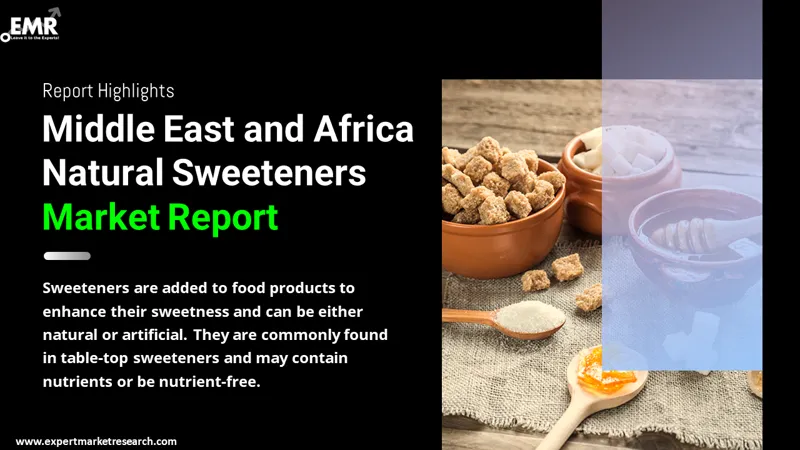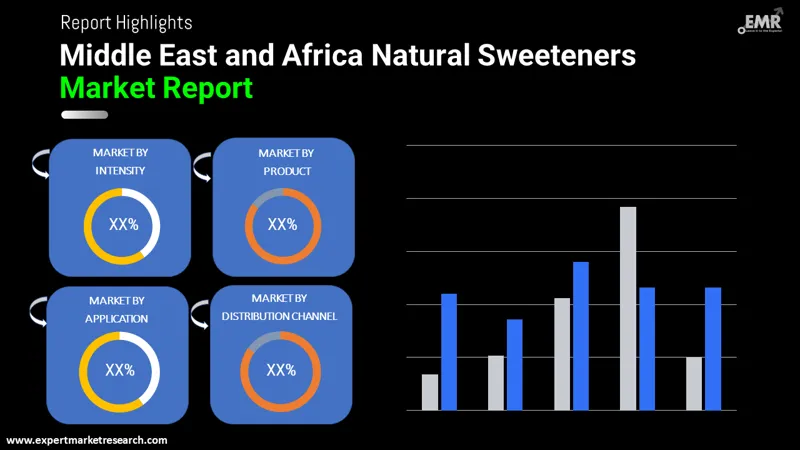
Consumer Insights
Uncover trends and behaviors shaping consumer choices today
Procurement Insights
Optimize your sourcing strategy with key market data
Industry Stats
Stay ahead with the latest trends and market analysis.
The Middle East and Africa natural sweeteners market attained a value of approximately USD 139.73 Million in 2025. The market is further expected to grow at a CAGR of around 8.30% in the forecast period of 2026-2035, reaching a value of around USD 310.15 Million by 2035.
Base Year
Historical Period
Forecast Period
Compound Annual Growth Rate
8.3%
Value in USD Million
2026-2035
*this image is indicative*
The rise in the industry was propelled by the increasing sales of zero calories food and beverage items devoid of artificial sweeteners. These items witnessed a growth of 16% in 2017, as compared to 2016. The market in the Middle East and Africa is being driven by the growing concerns about health with increasing incidences of obesity.
Globally, stevia is emerging as one of the most popular natural sweeteners available in the market. In 2018, the production value of stevia was worth USD 480 million, with its demand being nearly 3.5 thousand tons that year. While Asia Pacific and Europe are the leading markets for natural sweeteners accounting for almost 50% of the market share, the Middle East and Africa region is also a significant emerging market for natural sweeteners.
Innovations in the alternative sweeteners industry is adding to the market growth of natural sweeteners globally. While natural sweeteners like stevia find their foremost use in the food and beverages sector, the pharmaceutical sector is also expected to emerge as a leading application sector in the forecast period of 2026-2035. Stevia, especially, is finding uses in the home and personal care segment along with being used in toothpastes and supplements.

Read more about this report - REQUEST FREE SAMPLE COPY IN PDF
Sweeteners are used to increase the sweetness of food products to which they are added. Usually used in table-top sweeteners, ready to be consumed, they can either be natural or artificial. They can also contain nutrients or be devoid of them. On the basis of their sweetness as compared to sucrose, they are divided into high intensity and low-intensity sweeteners.
Market Breakup by Intensity
Market Breakup by Product
Market Breakup by Application
Market Breakup by Distribution Channel
Market Breakup by Country

Read more about this report - REQUEST FREE SAMPLE COPY IN PDF
Rising concerns related to health and a growing awareness about the detrimental effects of sugar are driving the growth of the global natural sweeteners market. With a rising number of people afflicted with obesity and diabetes, health regulatory authorities are seeking to curb excess sugar and calorie intake through taxations, pack labelling, and other schemes. This, in turn, has provided an upward push to the global natural sweeteners industry.
With consumers becoming increasingly apprehensive about artificial sugar alternatives, the market for natural sweeteners is finding further impetus for its growth. Major companies are looking to invest in sweeteners that are natural and are able to replace sugar in all aspects including its properties which add to the texture, bulk, colour, and shelf life of products.
The Middle East and Africa, the industry is being propelled by the rising demand for low-calorie alternatives to sugar to tackle the obesity problem. Almost 27% to 40% of the population in countries like Saudi Arabia, Kuwait, Qatar, Bahrain, and the UAE are suffering from obesity. With increasing awareness of the ill-effects of obesity on health, the consumers in the Middle East and Africa region are seeking natural and low-calorie products, thus, driving the natural sweetener industry in the area. The growing populations combined with rising purchasing power is also aiding the natural sweetener industry in the region. Egypt and South Africa are the major producers of natural sweeteners in the region.
Stevia is a leading natural sweetener in the global as well as the Middle East and Africa market. In 2016, the Gulf Cooperation Council’s (GCC) Standardization Organization (GSO), finalised its regulations on the application of steviol glycosides in food and beverage segments like breakfast cereals, non-alcoholic drinks, bakery products, canned and bottled fruit, jams, marmalades, confectionary, and nectars, among others. This has aided the industry growth of stevia in the region with companies undertaking various initiative to develop new products containing stevia.
The report presents a detailed analysis of the following key players covering their capacities, market share and latest turn of events such as mergers and acquisitions, capacity expansions and plant turnarounds in the Middle East and Africa sweeteners market:
Further, the report sheds light on the macro and micro aspects of the industry performance, recent trends, major challenges, and key drivers. SWOT analysis, value chain analysis and Porter’s five forces analysis of the market have been carried out. Manufacturing and processing requirements, cost of the project, project funding, returns on investment and expected profit margins have also been estimated.




*While we strive to always give you current and accurate information, the numbers depicted on the website are indicative and may differ from the actual numbers in the main report. At Expert Market Research, we aim to bring you the latest insights and trends in the market. Using our analyses and forecasts, stakeholders can understand the market dynamics, navigate challenges, and capitalize on opportunities to make data-driven strategic decisions.*
Get in touch with us for a customized solution tailored to your unique requirements and save upto 35%!
The market is expected to grow at a CAGR of around 8.30% in the forecast period of 2026-2035.
The major drivers of the market include rising disposable incomes, increasing population, growing concerns related to health, and the growing awareness about the detrimental effects of sugar.
The health regulatory authorities are seeking to curb excess sugar and calorie intake through taxations, pack labelling, and other schemes. This is expected to be a key trend for the market.
South Africa, Saudi Arabia, Nigeria, Egypt, and the United Arab Emirates, among others, are the leading regions in the market.
The leading types of natural sweeteners in the market are stevia, maple syrup, raw honey, molasses, and coconut sugar, among others.
The food, beverages, pharmaceuticals, and personal care sectors, among others, are the major application segments in the market.
The leading players in the market are PureCircle, Ingredion Incorporated, Cargill, Incorporated, Tate & Lyle PLC, Archer Daniels Midland Company, Tereos S.C.A., Wilmar Sugar Pty Ltd., Ingredion South Africa (PTY) , Others.
Explore our key highlights of the report and gain a concise overview of key findings, trends, and actionable insights that will empower your strategic decisions.
| REPORT FEATURES | DETAILS |
| Base Year | 2025 |
| Historical Period | 2019-2025 |
| Forecast Period | 2026-2035 |
| Scope of the Report |
Historical and Forecast Trends, Industry Drivers and Constraints, Historical and Forecast Market Analysis by Segment
|
| Breakup by Intensity |
|
| Breakup by Product |
|
| Breakup by Application |
|
| Breakup by Distribution Channel |
|
| Breakup by Country |
|
| Market Dynamics |
|
| Competitive Landscape |
|
| Companies Covered |
|
| Report Price and Purchase Option | Explore our purchase options that are best suited to your resources and industry needs. |
| Delivery Format | Delivered as an attached PDF and Excel through email, with an option of receiving an editable PPT, according to the purchase option. |
Single User License
One User
USD 3,999
USD 3,599
tax inclusive*
Datasheet
One User
USD 2,499
USD 2,249
tax inclusive*
Five User License
Five User
USD 4,999
USD 4,249
tax inclusive*
Corporate License
Unlimited Users
USD 5,999
USD 5,099
tax inclusive*
*Please note that the prices mentioned below are starting prices for each bundle type. Kindly contact our team for further details.*
Flash Bundle
Small Business Bundle
Growth Bundle
Enterprise Bundle
*Please note that the prices mentioned below are starting prices for each bundle type. Kindly contact our team for further details.*
Flash Bundle
Number of Reports: 3
20%
tax inclusive*
Small Business Bundle
Number of Reports: 5
25%
tax inclusive*
Growth Bundle
Number of Reports: 8
30%
tax inclusive*
Enterprise Bundle
Number of Reports: 10
35%
tax inclusive*
How To Order

Select License Type
Choose the right license for your needs and access rights.

Click on ‘Buy Now’
Add the report to your cart with one click and proceed to register.

Select Mode of Payment
Choose a payment option for a secure checkout. You will be redirected accordingly.
Gain insights to stay ahead and seize opportunities.

Get insights & trends for a competitive edge.

Track prices with detailed trend reports.

Analyse trade data for supply chain insights.

Leverage cost reports for smart savings

Enhance supply chain with partnerships.

Connect For More Information
Our expert team of analysts will offer full support and resolve any queries regarding the report, before and after the purchase.
Our expert team of analysts will offer full support and resolve any queries regarding the report, before and after the purchase.
We employ meticulous research methods, blending advanced analytics and expert insights to deliver accurate, actionable industry intelligence, staying ahead of competitors.
Our skilled analysts offer unparalleled competitive advantage with detailed insights on current and emerging markets, ensuring your strategic edge.
We offer an in-depth yet simplified presentation of industry insights and analysis to meet your specific requirements effectively.
Share